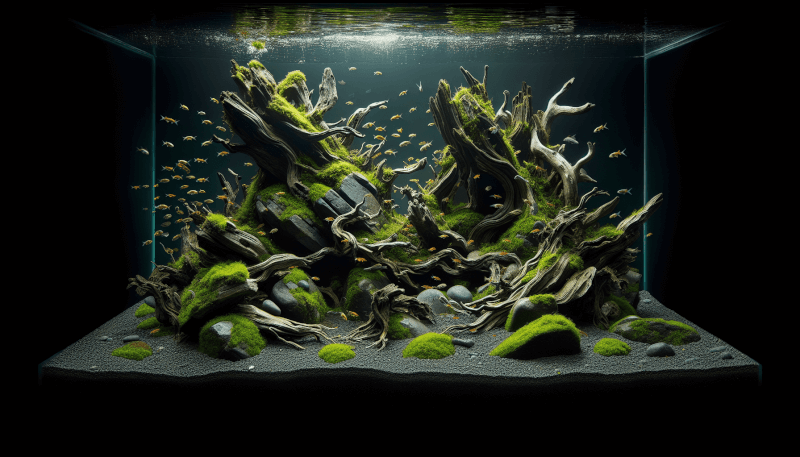In the world of aquariums, there’s a subtle art to creating a captivating underwater landscape. If you’re looking to enhance the aesthetics of your fish tank, look no further than the natural beauty of rocks and driftwood. With their unique shapes, colors, and textures, rocks and driftwood can transform your aquarium into a mesmerizing aquatic paradise. From creating stunning focal points to providing hiding spots for your aquatic friends, this article will guide you through 10 creative ways to incorporate rocks and driftwood into your aquarium aesthetics. Get ready to dive into a world of aquatic creativity!
1. Selecting the Right Rocks
When selecting rocks for your aquarium, it is important to consider the water parameters. Certain rocks can have an impact on the pH levels and hardness of the water. So, it is crucial to choose rocks that are compatible with your desired water conditions. Additionally, rocks with interesting shapes and textures can add visual appeal to your aquarium. Look for rocks that have unique formations, such as caves or overhangs, that can provide hiding spots for your fish. Lastly, avoid using rocks that may alter the water chemistry. Some rocks, like limestone or marble, can raise the pH levels of the water, which may not be suitable for all types of fish.
2. Preparing Rocks for Aquarium Use
Before placing rocks in your aquarium, it is essential to clean them thoroughly. Rocks may contain dirt, dust, or other contaminants that can negatively impact your aquarium’s ecosystem. Rinse the rocks under warm water and scrub them lightly with a brush to remove any debris. It is also important to test the rocks for safety. Some rocks may contain minerals or elements that are harmful to your fish or other aquatic animals. To test the rocks, you can soak them in a bucket of water for a few days and monitor for any changes in the water quality. Additionally, curing rocks can help remove any potential toxins or contaminants. This can be done by soaking the rocks in clean water for a few weeks, changing the water regularly.

3. Creating Natural Rock Formations
Once you have selected and prepared your rocks, you can start creating natural rock formations in your aquarium. Stacking rocks can form caves and hiding spots for your fish, providing them with a sense of security. Be careful to create stable formations that won’t collapse and harm your fish. Another way to incorporate rocks is by arranging them to create interesting landscapes. Consider varying the heights and angles of the rocks to add depth and dimension to your aquarium. Additionally, using rocks to divide the aquarium into different zones can create distinct areas for different types of fish or aquatic plants.
4. Incorporating Driftwood for Visual Appeal
In addition to rocks, driftwood can also be a great addition to your aquarium aesthetics. When choosing driftwood, it is important to select the right type that is safe for your aquarium. Some types of driftwood, such as pine or cedar, can release harmful substances into the water. It is best to choose driftwood that has been properly treated and cured to ensure it is safe for your fish. Boiling or soaking the driftwood can help remove tannins, which can tint the water. Positioning the driftwood in your aquarium can create natural-looking habitats for your fish, mimicking their native environments.

5. Using Rocks and Driftwood for Aquascaping
Aquascaping is the art of arranging aquatic plants, rocks, and other decorations in your aquarium. It can create a visually pleasing and natural-looking environment for your fish. Rocks and driftwood can play a significant role in aquascaping. Placing plants on or around rocks and driftwood can create a seamless transition between the aquatic and terrestrial elements in your aquarium. Consider using moss, ferns, or other plants that can attach to the rocks or wrap around the driftwood. Creating a focal point with a centerpiece rock or driftwood can draw attention and create a visually striking display. It can be a larger rock or a unique piece of driftwood that stands out from the rest of the decorations. Balancing and contrasting textures with vegetation can add visual interest to your aquarium. Mixing textures like rough rocks with delicate plants can create a visually dynamic and pleasing aesthetic.
6. Providing Hiding Places for Fish
Hiding places are essential for fish, especially for shy or territorial species. Rock formations can provide natural shelters where fish can retreat when they feel stressed or threatened. By incorporating rocks with crevices and small caves, you can create hiding spots that mimic their natural habitats. Driftwood can also be utilized to create cozy nooks and crannies for fish to seek refuge. It is important to arrange the rocks and driftwood in a way that allows fish to navigate easily and doesn’t create dead ends or trapping points. By mimicking natural habitats and providing hiding places, you can help reduce stress and promote a healthier environment for your fish.

7. Enhancing Water Movement and Filtration
Rocks and driftwood can be strategically positioned to enhance water movement and filtration in your aquarium. By placing rocks in a way that guides water flow, you can create gentle currents and prevent stagnant areas. This can improve oxygenation and nutrient distribution within the tank. Rocks can also be used to create cascades or waterfalls, adding a visually appealing element to your aquarium while promoting water circulation. Driftwood can create natural currents and eddies as water flows around and through its intricate branches. These natural currents can help improve oxygen levels and provide additional filtration for your aquarium.
8. Fostering Beneficial Bacterial Growth
Beneficial bacteria play a crucial role in maintaining a healthy aquarium ecosystem. Rocks can provide a porous surface area where these bacteria can thrive. Choosing rocks with a rough or porous texture can maximize the surface area available for bacteria colonization. These bacteria help break down waste and toxins, contributing to the overall water quality. Driftwood can also promote biofilm growth, another valuable source of nutrition for your aquatic animals. It is important to ensure proper water flow around rocks and driftwood to maximize the contact between the water and the beneficial bacteria.

9. Creating Natural Breeding Areas
If you have breeding fish in your aquarium, rocks and driftwood can be used to create natural spawning sites and nesting areas. By arranging rocks in a way that forms crevices or small caves, you can provide safe and sheltered areas for fish to lay their eggs. The crevices should be of an appropriate size to prevent the eggs from being easily accessed and eaten by other fish in the tank. Similarly, positioning driftwood can mimic natural nesting areas for fish that prefer spawning on or near woody structures. Creating suitable breeding environments can encourage successful reproduction and increase the chances of fry survival.
10. Maintenance and Cleaning Tips
Regular maintenance and cleaning are essential to ensure the longevity and health of your aquarium. It is important to regularly inspect rocks and driftwood for any signs of deterioration, such as cracks or rot. Damaged rocks or driftwood should be removed and replaced to prevent potential harm to your fish or disruption of the ecosystem. Algae and debris can accumulate on the surfaces of rocks and driftwood, affecting their visual appeal and potentially impacting water quality. Regularly clean these decorations by gently scrubbing off algae using a soft brush. If necessary, you can remove the rocks or driftwood from the tank and give them a more thorough cleaning. When handling rocks and driftwood, be cautious to avoid introducing any harmful substances or contaminants into your aquarium.


